

The Kufra Convoys
Sources:
November 2002 - Strange Wadi Sora brass container apparently identified, by Stuart Disbrey |
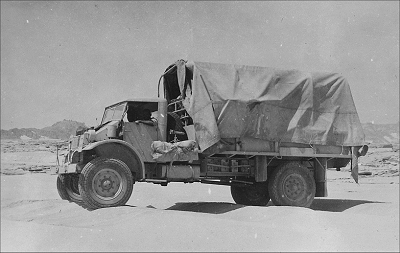
|
It is little known, but the Libyan Desert was the scene of one of the greatest logistical feats of WWII. After the capture of Kufra by Leclerc in February 1941 it became apparent, that the French have neither the manpower nor the logistical capability to maintain a garrison, and the task fell on the Sudan Defence Force. All supplies for the subsequent two years had to be trucked in from Wadi Halfa on the Nile, accross 1200 kilometres of barren and waterless desert. The convoys standard routes went via Selima Oasis, Bir Missaha and Jebel Kamil to the southern tip of the Gilf Kebir, either rounding it or crossing Wadi Firaq or Wadi Wassa. From there the convoys turned North, passed the 'Three Castles' and Wadi Sora, then continued via Mushroom Rock, "Bab al Misr" and Kendall's Dump to Kufra. To this day a number of relics still remain scattered in the desert. There is a wrecked 10 ton 6wd White truck on the plain a little south of the Aqaba pass, a half burried 1.5 ton '42 Ford truck by the dunes opposite the mouth of Wadi Bakht, a '40 Maple Leaf Chevrolet and several other scattered wrecks to the east of the Gilf.
There are the remnants of an 1940 Maple Leaf Chevrolet out on the plain to the west of Wadi Sora. This too certainly belonged to the Kufra convoys, and apart of the removal of all usable parts, the remains are in an excellent state of preservation.
Near the pass over the sand dunes from Jebel Uweinat to Jebel Arkenu (and then on to Kufra) there are the wrecked and scattered remains of a 1 ton 1940 Ford 01Y V8 truck that most probably was also a part of the convoys, though this has not been confirmed (one variation of the route, soon abandoned for the regular route via the Gilf Kebir due to some difficult terrain, went from Selima direct to Uweinat, then on to Kufra).
In March 2007 we have come accross the remains of a CMP Ford F30 (the V8 engine is a clear giveaway, Chevrolets had a six cylinder in-line engine) 30cwt light lorry near the northern edge of the Selima Sand Sheet, about 60 kilometres east of the Gilf Kebir. As the location was somewhat north of the regular convoy tracks, this one may have been a vehicle of the LRDG 'heavy section' taking supplies to Kufra from Cairo.
There is another wrecked 30cwt CMP Ford (or Chevrolet ?) along the Eastern edge of the Gilf Kebir.
A short distance south of the previous wreck, there is another one which is not firmly identified. The wooden platform gives it away as a Chevrolet 1311x3 15cwt patrol car, with an added machine gun mount on the front left. A few of this model were used by the LRDG from late 1941 as the early patrol car (alongside the 'standard' 30 cwt 1322x2 which had a full metal body), but also by the SDF as a pilot car for the Convoys. The location of the wreck is very close to where the convoys had to round the dunes to the east of the Gilf Kebir to be able to enter Wadi Wassa, the northern route through the Gilf Kebir, however the easiest route from Cairo to Kufra would have also been along this way. There is no evidence that the SDF pilot cars had mounted machine guns, and there is a good match with photos of the LRDG 1311x3 staff car, making this wreck the only likely candidate for a 'real' LRDG vehicle aside the abandoned LRDG Rhodesia CMP Ford near Ain Dalla.

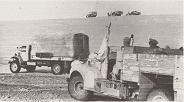
I have not seen it, but there are photos circulating on the web of another, practically intact 30cwt CMP Ford (or Chevrolet) stuck on the Selima Sand Sheet near the Egypt - Sudan border, certainly another abandoned SDF convoy vehicle.
We came upon two previously unreported wrecks along the convoy route between Selima Oasis and jebel Kamil. These are in a remarkably good state of preservation on account of being away from all presently traveled tracks. One is a CMP Chevrolet C60L with a model 12 cab, the principal workhorse of the convoys in 1942, the other is a Ford F30 with a model 11 cab.
While all these wrecks are still in their original resting place, there was one very special vehicle which is no longer in its original position. It was found by Rudolph Kuper and Samir Lama in 1993. It is a CMP Ford F60L truck, loaded with crates of 37mm anti-tank rounds with high explosive projectiles (note, as the cartridges are packed in protective cases, they were mistaken for 'dynamite' by the discoverers). The location was quite far north, in the vicinity of "two breasts" near the North-eastern approaches of the Gilf Kebir, a good 50 Km from the closest frequented convoy route. Also the top of the cab was removed to lighten the vehicle, LRDG style. While there is no direct evidence, it is not impossible that this truck belonged to the LRDG transport section, and not to the SDF. On the other hand the cargo would suggest that it was indeed a SDF truck that perhaps became lost and ran out of fuel. While the LRDG did use the 37mm Bofors anti tank gun mounted on some patrol cars, these cartridges were intended for the US made M3 / M4 / M6 anti-tank gun used on light tanks and as a stand-alone weapon up to 1943 (both are 37mm calibre, but the Bofors used the 37x257R cartridge, while the M3 the 37x223R designated the M16), the LRDG would have had no need for such ammunition. The assembly date is listed as March 1942 on the packing label in one of the crates, so the truck must have been abandoned sometime after that date (of note: the M3A1 Stuart tank intended for the SAS and abandoned near Kufra sometime in 1942 used ths type of ammuniton).
The truck was removed to the El Alamein Museum by the Egyptian military in 1996. There are urban legends circulating that after inflating the tires, changing the battery and filling the tank with fuel the truck could be started again, but the truth is the truck was loaded onto a big lorry for its journey North. It was already on its pedestal in 1997, and after some period spent in a drab olive green paint it is now back in its original desert colours.
The convoy routes are littered with empty food tins, and the innumerable petrol flimsies. At Jebel Kamil there still remains a large stack of empty petrol tins, some with even the paper label remaining ! Further south accross the brder to Sudan, there is another large cairn of petrol tins at Jena Dump, an advance dump originally created by the SDF during the 1934 occupation of Karkur Murr.
On the perfectly flat plain near "Eight Bells", the runway markings of the airfiled are still visible, made out of burried petrol tins.
Near the airfield the ground is littered with discarded petrol and food tins.
There is another airfield near Wadi Sora, it's four corners marked with petrol tins, and a supply of petrol still in their original wooden boxes.
Not far from the Wadi Sora airfield, at the foot of one of the three conspicious rock spires on the plain, we have come upon a strange crumpled brass container of a very high quality workmanship. It is almost certainly of WWII vintage, but there is no label or inscription on it except for a few numbers. I have no idea of it's purpose or original contents. Dimensions are about 40 x 40 x 75 cm. If anyone recognises the container by the photos below, please let me know.
In the same general vicinity, we have come upon the remains of a shattered Rum Jar that was also likely discarded by one of the convoy drivers.
The Wadi Sora area appears to have been a particularly popular camping spot even in the convoy times, the plain outside the inlet is littered with rubish heaps and scattered memorabilia.
Further North the convoy route passed the narrow defile that Almásy nemed "Bab al Misr" (The gate of Egypt), this too was a popular resting and fueling place, there are a number of large caches of petrol tins in the area, one with the original cardboard packagings still intact.
However, the most lasting legacy of the convoys are the tracks. Dozens of deeply worn ruts testify to the immense volume of traffic that passed through, and crossing them can be a rather bumpy exercise. Near the Prince Kemal el Din monument there is a plain, about 2 kilometres wide, that is covered by deep parallel tracks to it's full width. Crossing at a right angle is near impossible, it takes a bumping and swaying 10 minutes to cross the 60 year old tracks !
Recently I have managed to obtain some historical photos on the Kufra Convoys. The first batch is from the album (which I have managed to acquire on an online auction site) of G.J. Mostert, engine mechanic, SAAF 15 Squadron, who was sent to Kufra as part of the detachment operatng the ill fated Bristol Blenheim aircraft. Mostert's diary (obtained together with the photos) records the Convoy crossing to have been accomplished in one week, in the period 17-24 April, 1942.
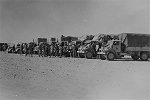

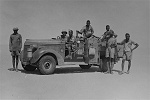
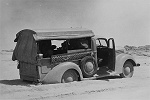
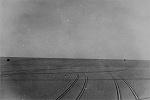
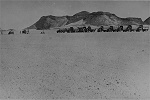
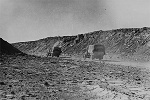
The second batch of photos were supplied by Tony W. Brooke, son of Frank Brooke, one of the Transport drivers (the 10 ton White 6x6 lorries were driven by British drivers) that carried 3 Gloster Gladiators (N5821, N5828 and N5851) of RAF 6 Sqdn. from Wadi Halfa to Kufra in September 1941. It is unclear why the planes were trucked, rather than flying them on their own power along the convoy route. These photos are significant not only because of the special load, but they are the only known photos to my knowledge depicting any of the White ten tonners in actual use in the Western Desert.
There is nothing published on the convoys. While the accomplishments of the LRDG are well known, war historians have completely ignored this unglamorous but immense feat. Not surprisingly Ralph Bagnold fully recognised the importance of the convoys. Amongst his personal papers deposited at the Churchill Archives, there are the draft chapters of an intended book on the history of the LRDG, the fifth of which described the SDF convoys. Bagnold never published these writings, instead it was W.B.K. Shaw who wrote the "official" LRDG history, undoubtedly using some of Bagnolds compiled material. However the Kufra convoys were left out, and their history forgotten...
The following is the text of the intended Chapter V, compiled by Major J.V. Simpson, March 1944:
In April 1941, coincident with the retreat in Libya, came the necessity of maintaining from the Sudan the newly captured oasis of Kufra. This demand has not been anticipated beforehand, but the S.D.F. met it successfuly. Fortunately it had in Bimbashi Lonsdale an officer who had already explored part of the route in peacetime.
Kufra is 650 miles North-west of Wadi Halfa, and while it offers almost every variety of desert surface and desert landscape there is nothing green over the whole route, except the miniature oasis of Selima, lying almost hidden in a crack in the earth's surface about 200 miles from Halfa. Water, not very palatable nature except when drunk in tea, available there. It is also available at Bir Mirsaha (sic) on an alternate route to the North, and at Uweinat about 400 miles from Halfa and to the south of the direct route to Kufra. So convoys were dependent on what they could carry, enough for drinking, but not for washing or shaving.
Though the sun could beat down in the daytime with fiery heat and not a scrap of shade anywhere, the desert nights were cool, and in winter intensely cold. All ranks in wintertime found five blankets absolutely essential.
The route maintained without much variation was Halfa - Selima or Bir Mirsaha - Sand Dune Gap - J Kamil - Eight Bells - Wadi Sura - Kendalls - Kufra. During July, August and September 1942, when there were signs of enemy activity around Kufra, attempts were made to find routes avoiding the long wadis - Wadi Farag and Wadi Sura, where there was a danger of ambush, but no practicable routes were found owing to the soft sand. "Kendalls" may also be mentioned. It is a very prominent group of jebels about 50 miles from Kufra, which was used as a site for dumps. In the earlier reports it is called "24/24" from its position 24o N 24,o E. Nobody seems completely sure how the name "KENDALLS" arose, but it is believed that it was a RE private engaged on constructing water tanks there, who has thus achieved immprtality. The name certainly caught on better than the alternate one of LARADAG (from L.R.D.G.)
Another difficulty was that the town of Wadi Halfa with the Railways and Dockyards all lies on the east bank of the Nile. Lorries, personnel and loads for Kufra, all had to be ferried across on barges, and when the river was flowing fast in flood a small tug might pull manfully for two hours before it reached the landing place. The troops quarters were all on the east bank and the workshops on the west bank, until the new buildings on the west bank were ready in September 1942.
60 vehicles were withdrawn from the Kassala area to start the convoys, and with some more from the Khartoum area, they set off by road from khartoum for the journey to Wadi Halfa on 17th April 1941. The convoy comprised:-
1 B.O. 2 N.O.s. 114 N.O.Rs.
4 Bren Vans
41 Ford 30 cwts
37 Maple Leaf Chevs.
1 Wireless Van
1 Ambulance
They moved by the desert route. 3 Chevrolets were lost through cracked cylinder heads, shades of what was to come.
The first convoy left Halfa on 28 April 1941 with a party of L.R.D.G. to act as guides. Seven Chevrolets had been lost by the time Bir Mirsaha was reached. Bimbashi Lonsdale decided then to go to Kufra with the Fords, leaving a native officer to follow to J. Kamil, where he was to dump his loads to be picked up and taken to Kufra again by the returning Fords.
The second convoy left halfa on May 18 with 20 Chevrolets and reached Kufra 8 days later with all its vehicles. Seven or eight days was the normal time taken over the journey. The fastest time ever made was 36 hours by two 15 cwts required to help in the rescue of some grounded aircraft.
The third convoy was less fortunate. 34 Chevrolets had to be left at Selima owing to shortage of fanbelts, a party was sent back to Halfa where it was understood there were plenty, but it only succeeded in obtaining enough to take 18 vehicles on to Kufra. Fanbelts were a constant worry on this route, the extreme heat caused rapid wear, sometimes on the Chevs the pulleys were out of alignment, the quality of the belts was poor and supplies were short.
In June 41, 19 ten-ton Mack Diesel lorries arrived over the desert from Shellal, after continuous trouble with the sand and without sand channnels. (Note: this could be an error - the photos of Frank Brooke show White 10 ton trucks transporting the Gloster Gladiators in September 1941, and the wrecked 6wd truck south of the Aqaba pass is also a White. The heavy transports could bave been a mix of Mack NR9 10 ton trucks and White 10 tonners, or just the latter.) The first convoy of Macks left for Kufra on June 14, and had to be left there because it had no A.G.O. left. The Mack lorries were always driven by British drivers.
In July, the first S.D.F. Troops were sent to Kufra to relieve the Free French, some of whom were taken in S.D.F. lorries as far as TEKRO the first oasis in Chad Territory.
Eleven more Mack lorries were received in August. One of the difficulties with these was tyre pressures. If pressure were high, there was a strain on the engine and sticking in the sand. If lowered, they ran more freely but developed punctures in the rocky places. 35 lbs was found to be a good average pressure. Patches put on with solution came unstuck with the heat, and vulcanised ones were hardly any more successful.
Sticking was not always due to tyre presures, though. One N.O. found vehicles sticking even when returning light from Kufra. He carried out an inspection of the loads, and found about 250 sacks of dates were secreted under the tarpaulins for sale at Halfa. He had them all unloaded and dumped at Kendalls, and there they remained as a warning to others.
No. 1 Service Coy had in its early stages no workshop, no workshops lorry and no recovery section. Many Chevrolets that have broken down in the desert were loaded on Mack lorries returning light to Kufra. Cannibalisation was of necessity often practised. Towards the end of 1941, breakdowns became more frequent owing to the strain on the vehicles. Cases of cracked cylinder heads, broken big ends, broken pistons, even broken gear boxes were common. The oil consumption of the fords and Macks also shot up.
During 1941 5 convoys per month were run to Kufra, each section making one journey, total payload approx. 250 tons, but in 1942, the number had to be increased. One section of 34 R.M.T. Coy was sent to Halfa in February to be followed later by the whole company. Chevrolet C-60-L type came into use. The average convoy consisted of 30 of these vehicles, 20 for payload and the remainder for domestic petrol and oil. Extra convoys were sent to Selima or Bir Mirsaha to dump petrol to make as much payload space available as possible, but the ratio of 2:1 was never materially changed. The same ratio also applied to the Macks. The payload was restricted to 21/2 tons for the 3 tonners and 6 to 61/2 tons for the Macks, the latter being increased later to 71/2 tons.
In July 1942 the route was marked out with poles every 5 miles and petrol tins betwen as far as the Sand Dune Gap. Bir Mirsaha came into use instead of Selima owing to its better water supply.
After August 1942 every possible vehicle had to be pressed into service to supply Kufra. Convoy turn-rounds had to be speeded up. One was actually off again 23 hours after arriving back at Halfa. this could only be done by organising maintenance squads of 10 men who took over the vehicles for cleaning, oiling and greasing as soon as they arrived, and gave the drivers a few hours rest. Two platoons of No. 34 Coy and some of the ten-ton Macks carried troops on the raid from Kufra to Jalo in September 1942.
At the end of November the prssure to maintain Kufra suddenly ceased, and it became possible to run convoys there from Cyrenaica. No. 1 Service Coy, later 55 R.M.T. Coy, later 417 Gen Tpt Coy, left Halfa for the last time on Jan 6, 1943, proceeded to Kufra and then to Tobruk, which it reached on January 29th. No. 43 R.M.T. Coy, now 120 Gen Tpt Coy, had preceded it having left Halfa on Nov 26 and reached Tobruk on Jan 16.
During the period Sep - Dec 1942, 57 R.M.T. Coy (later 655 gen Tpt Coy) was added to the Kufra Convoy, as well as:-
No. 13. Indian Infantry Brigade Ord Coy.
L.R.S. Sudan Ordnance Corps.
L.A.D. Sudan Ordnance Corps.
L.R.S. Indian Ordnance Corps.
The latter two were located at Bir Mirsaha. The commitments at this time were 1,000 tons per month. The main troubles at that time were due to big ends and gear-boxes. The spares situation was difficult, and the vehicle wastage reached 25%. In spite of all this only one lorryload failed to reach Kufra.
In addition to organised maintenance squads, the workshops of all the companies engaged were grouped under one command to make the best use of the available resources.
The Mack lorries and their personnel comprised two sectoons of No. 4 L of C Coy, which had its headquarters in the Middle East. These two sections were in 1942 formed into a separate new company 569 Gen Tpt Coy. Six of its vehicles with their drivers were lent to the L.R.D.G. in the autumn of 1942. One of them was lost by enemy action. The company has since moved to Mideast.
The early convoys pointed to the necessity of medical orderlies on long convoy journeys, as apart from the usual cuts and bruises, cases of malaria sometimes occur. Native Medical Orderlies did good work on the later convoys, while when pressure was greatest, it was found desirable to have an M.O. on the West Bank to meet incoming convoys.
No fresh meat was available in Kufra. The experiment was tried of sending meat from Halfa in a large captured Italian Ice Chest mounted on a 10-ton mack. Well packed with ice, the meat reached Kufra in excellent condition.
All British troops on the convoys and in Kufra were fed on the L.R.D.G. scale.
The War Diary of Kufra Garrison is silent on the subject of supplies except for one mournful entry:-
"Dec 19 1941. The long awaited Garrison Bakery was to have its opening bake, but the cook Sgt has cut his hand with a razor".
Correspondence on the possible purpose of the brass container
From: Ignacio Recalde
Sent: Tuesday, August 06, 2002 1:47 PM
Subject: RE: Uwaynat
Hi Andras,
Well, some things to consider about the brass box:
1. Volume: 0.70x0.40x0.40 = 0.112 m3 = 112 l. = 30 U.S. gallons = 24.7 Imperial gallons. If we consider that it has 2 handles, it was designed to be carried by 1 or 2 people. If it contained a liquid, the lightest is gasoline and then the weight would be 84 Kg. Carrying the box between 2 would mean 42 kg each, whith such a handle it would be at least painful. So we can discard any liquid or good with spgr more than 1, that is, heavier than water. (bank notes would have 1.25 spgr). Whatever the content it had to be quite light, because if the container is 70 cm. high for someone like me (1.73 m.) would be difficult to transport as I could not have my arms fully extended otherwise it would touch the ground.
2. Material: Brass was one of the preferred corrossion proof materials before WWII. Even WC floats were made of brass. So that is intriguing, why should you need a corrossion proof material in the desert? Maybe to leave it alone for years? It was that or maybe for some reason it was even more important not to have rust inside instead of outside.
3. Shape: paralepipedic box shape is useful for stowage as maximizes useful space. So we can guess that tin at some stage travelled together with other similar tins, otherwise a cilindrical shape is cheaper and stronger. Being tied to similar tins also allows each tin to be individually not so stiff, and clearly that one was not impressively stiff.
4. Closure. I don't understand clearly from the picture the way the lid was fixed. However, a circular lid possibly points out a watertight closure.
So, what can we guess? I don't know, but this tin being part of a cargo of tea for the whole garrison of Kufra, arrived to Alexandria from India and taken through the desert could be a possibility as you know how Imperial British people were. It is light, it has to preserve its humidity (so it needs a watertight tin), this humidity should not produce rust inside the tin, as then the tea would be tainted and it is valuable enough to justify a brass tin. I don't mean it was tea indeed, I'm curious to any other suggestions, I would have prefered to talk about that at a night camp at Uwaynat than through the Internet.
Best Regards,
Ignacio Recalde
From: Stuart Disbrey
Sent: Thursday, November 14, 2002 11:14 AM
Subject: Your box explained
Andras -
I think we have a positive identification.
A chap I know who is a munitions expert has a box exactly the same in perfect condition (I'll try to get you a pic).
It is French, most likely naval in origin and is a cordite/primer/explosive deck store. Hence the brass construction (it won't rust) and water tight lid.
I would guess that it was transported from a port, by convoy to supply medium/heavy artillery. So it looks like a relic of Leclerc's time at Kufra.
Hope that helps,
Cheers, Stuart.
Mostert was aircraft and engine mechanic of the SAAF 15th Squadron. His 1942 diary and photographs reveal the fascinating story of the detached flight to Kufra, but also provides a rare glimpse into the everyday events of the Desert War.
The story of three ill fated Blenheim bombers and their crew of the SAAF 15th Sq. detachment, from unpublished documents
The contents of a find near Wadi Sora, the complete personal belongings of signalman Alexander (Alec) Ross, dispatch rider for the LRDG
Unpublished historic photos of the 1934 occupation of Bir Murr by the Sudan Defence Force, courtesy Anthony & Philip Arkwright
The fascinating story of intrigue and espionage, revealed through a series of hitherto unpublished letters by W.J. Harding King
László Almásys most daring Mission in the Desert War
The story of one of the most daring secret operations of the Desert Campaign in the Second World War. A mission far behind the enemy lines, thousands of kilometers through the most arid corner of the Sahara desert, in order to deliver two German spies into the very heart of British-held Egypt.